Ad
Transform the internal it landscape with APIs and integration
- 1. Transforming Enterprise IT with Containers, APIs and Integration Steven Willmott, Senior Director and Head of API Infrastructure Red Hat Inc. @njyx, [email protected]
- 2. Microservices, Containers, APIs & Integration Days 2018 APIs on the Edge, APIs in the Middle 2
- 3. Microservices, Containers, APIs & Integration Days 20183 EXAMPLE RED HAT 3SCALE CUSTOMERS Customer Depth and Breadth - One of the Largest API Management Vendors Globally.
- 4. CONTEXT
- 5. 5 COMMON CHALLENGES IN MODERN IT INFRASTRUCTURE Integrate SaaS Apps Extend Legacy Apps Customer and Partner Access IoT Devices and Architectures Enable Customer Facing Apps via Many Channels Data Access for Business Users
- 7. Microservices, Containers, APIs & Integration Days 2018 What do APIs Really Do? 7 Provide Stable Reusable Interfaces
- 8. Microservices, Containers, APIs & Integration Days 20188 MOST COMMON API USE-CASES Mobile & IOT Support Customer Integration Partner Ecosystem Internal Agility APIs as a Business Content & Transaction Channel
- 9. Microservices, Containers, APIs & Integration Days 2018 Lines between Internal and External APIs are Blurring 9
- 10. 10 INTEGRATION AND APIs DRIVE AIR TRAVEL INNOVATION ● Schiphol Airport aims for world class traveller experiences ● Using Red Hat JBoss Fuse to create the right API endpoints and then putting them in the hands of partners creates an extended team to deliver innovation ● Flight, baggage, reservation, and other data are available throughout the airport and to all partners ● APIs through API Management provide the foundation for seamless handoff between the airport and its partners APIs - Well defined, re-usable, and well managed end-points - Ecosystem leverage
- 11. 11 CAMPELL’S SOUP: APIs LEAD TO A BREAKTHROUGH NEW CUSTOMER CHANNEL ● Initially created a Nutrition and Recipies API to be used by marketing agencies and application designers ● Reaching new audiences with the recipie application “Campell’s Kitchen” on the Amazon Echo device. ● Very high value brand interaction in the customers’ residence. ● Leading to possible Integration with Amazon shopping cart to provision for recipes APIs - Partner Marketing Resource to IoT Backend - Now Powers Campell’s Kitchen
- 12. 12 UNIVERSITY CALIFORNIA AT BERKELEY - INTERNAL AND EXTERNAL APIS ● API Central Program ● Student and Study information, University Core Systems APIs ● But also filtered access to external APIs such as Dropbox, Google Maps to provide an extensive list of APIs ● Platform for new applications in the student body as well as new new inter-department integrations APIs and Organization - IT Organization but... - Providing Student Access - New Apps and Mashups
- 13. Microservices, Containers, APIs & Integration Days 201813 EXAMPLE RED HAT 3SCALE CUSTOMERS Customer Depth and Breadth - One of the Largest API Management Vendors Globally.
- 14. HOW DO WE ACTUALLY SUCCEED?
- 15. Microservices, Containers, APIs & Integration Days 201815 THE API OWNER’S MANUAL ● Captured learning from successful API teams ● Reinforced by recent experience ● Digital Copy: https://engage.redhat.com/3scale-api-ow ners-s-201706160312
- 16. Microservices, Containers, APIs & Integration Days 2018 Three Things.... 16
- 17. Microservices, Containers, APIs & Integration Days 2018 1. Focus on True Value 2. Enable rather than Own 3. Transformation, not Revolution 17
- 18. #1 Focus on True Value
- 19. Many initiatives, all urgent, all intersecting, all conflicting
- 20. Jeff Bezos moment? https://plus.google.com/+RipRowan/posts/eVeouesvaVX (http://bit.ly/SWGA-B)
- 21. 21 Outcomes Thor Mitchell / Google / Crowdcube DesirableUndesirable Expected Unexpected Design Fire Drill Innovation Prohibited
- 22. M ajor platform investm ents Little initial traction Revisited all processes EXAMPLE: MAPS CREDIT UNION https://www.youtube.com/watch?v=ylX3hUeYr-U (http://bit.ly/SWGA-C)
- 23. Understand the Jeff Bezos moment: change the way you work, not the infrastructure you have
- 24. Lesson: Help move the puck as you go
- 25. #1 Focus on True Value #2 Enable rather than Own
- 26. Bimodal IT ...
- 27. “Gartner’s Recipe for Disaster” - Jason Bloomberg / Forbes “Gartner’s Bimodal IT considered harmful” - Phil Wainwright / Diginomica “This is akin to adding lipstick to the pig” - Simon Wardley / CSC
- 28. Fundamental misunderstanding of Bimodal IT that it was about slowing down one of the Modes
- 29. Actually it is about creating stability between the modes
- 33. Platform Team Platform Enablement Team
- 34. Encourage deployment but… Provide Technology Guidance Impose Stability Requirements Require Lifecycle Statements Enforce Documentation Standards Enforce Security Standards In other words ensure stability
- 35. Create the right environment… Automation is Key Treat as a Capability to run APIs Treat APIs as Products
- 36. Lesson: Enable the platform versus owning the platform
- 37. #1 Focus on true value #2 Enable rather than own #3 APIs as a Product
- 38. What is an API?: REST? RESTful? SOAP? Streaming? ...
- 39. Microservices, Containers, APIs & Integration Days 2018 It’s the Mindset that is Important 39
- 40. Microservices, Containers, APIs & Integration Days 2018 The Product Mindset 40
- 41. What does that mean? Clear Ownership and Responsability Identifiable Audience and User Base Documentation and Onboarding Help Service Level Agreements Proper Lifecycle Management Recognition that people depend on the API
- 42. APIs Matched ProductOnly two breaking changes in 10 years Customer Feedback loop EXAMPLE: 3SCALE Noahm Schwartz, APIStrat, 2015
- 43. Millions of devices syncing Robust libraries & dev collaboration Randomized back off EXAMPLE: FITBIT Jeremiah Lee, San Francisco, 2016
- 44. W eb Ranking API Realized plugins were critical Plugins now drive majority of business EXAMPLE: SIMILAR WEB Noahm Schwartz, APIStrat, 2015
- 45. Lesson: Treat APIs a Products. This pushes you into the right interactions
- 46. #1 Help move the puck #2 Enable rather than own #3 APIs as a Product Bonus: What to Measure?
- 47. Bad Metrics Number of APIs Number of API Calls Number of Integrations Number of Containers Number of Servers Number of Lunch & Learns
- 48. Good Metrics Number of Apps Supported Number of complete Use Cases Number of Users Dollar Value of Business Speed of Application development Speed of API Deployment
- 49. TAKE AWAYS...
- 50. Microservices, Containers, APIs & Integration Days 2018 ● Incremental transformation ● Creating a new organizational capability ● Treating APIs as products rather than resources 50
- 51. Microservices, Containers, APIs & Integration Days 201851 THANK YOU FOR YOUR TIME! ● APIs will very likely be a key architectural component for most organizations ● Red Hat is investing heavily and aiming to be a long term partner ● Agile Integration, Container Management and API Management will be a key architectural pillars for the next 3-5 years
- 52. Microservices, Containers, APIs & Integration Days 201852 FOLLOW UP MATERIAL ● Red Hat Integration homepage: https://www.redhat.com/en/technologies/jboss-middleware/integrate ● “Inside mind of a successful platform architect / Gartner APPS 2016” https://www.slideshare.net/3scale/inside-mind-of-a-successful-platfor m-architect-gartner-apps-2016 ● “API Model Canvas for successful API strategies and programs” https://www.slideshare.net/3scale/api-model-canvas-for-successful-ap i-strategies-and-programs ● “The API Owner’s Manual” https://www.redhat.com/en/resources/3scale-api-owners-manual-ebo ok
- 53. THANK YOU & Q&A! Steven Willmott [email protected], @njyx
- 54. Microservices, Containers, APIs & Integration Days 201854 THREE PILLARS FOR INFRASTRUCTURE AGILITY Key capabilities for modern software infrastructure agility DISTRIBUTED INTEGRATION -LIGHTWEIGHT -PATTERN BASED -EVENT ORIENTED -COMMUNITY SOURCED CONTAINERS - CLOUD NATIVE SOLUTIONS -LEARN ARTIFACTS, INDIVIDUALLY DEPLOYABLE - CONTAINER BASED SCALING AND HIGH AVAILABILITY APIs -WELL DEFINED, REUSABLE, AND WELL MANAGED END-POINTS -ECOSYSTEM LEVERAGE FLEXIBILITY SCALABILITY RE-USABILITY Tools and Processes
- 56. 56 INTEGRATION DRIVES CONSISTENT CUSTOMER EXPERIENCE Containers Distributed integration ● Avianca built and deployed a faster, more robust and consistent enterprise infrastructure to integrate applications ● Deployed Red Hat JBoss Fuse based integration to support applications for business-critical functions such as sales, ticketing, back office, and maintenance ● Faster integration of new companies and services ● Consistent customer experience across sales, ticketing & back office applications - path towards omni-channel experience - Lightweight - Pattern based - Event oriented - Community sourced
- 57. 57 KEYBANK: SIMPLIFYING AND ACCELERATING DEVELOPMENT CYCLES ● Long development cycles. Small under-resourced release team and a wide range of compliance checks required ● Container deployment and management across a broad set of developers. Shrank release times from 2-3 months to 1 week ● Also empowered more people to act and release - key effect on organizational dynamics Containers - Retooled development and deployment entirely - Broader availability and faster rollouts
- 58. 58 INTEGRATION AND APIs DRIVE AIR TRAVEL INNOVATION ● Schiphol Airport aims for world class traveller experiences ● Using Red Hat JBoss Fuse to create the right API endpoints and then putting them in the hands of partners creates an extended team to deliver innovation ● Flight, baggage, reservation, and other data are available throughout the airport and to all partners ● APIs through API Management provide the foundation for seamless handoff between the airport and its partners APIs - Well defined, re-usable, and well managed end-points - Ecosystem leverage
- 59. REDHAT 3SCALE PRODUCT ANNEX
- 60. Microservices, Containers, APIs & Integration Days 201860 Control ● Security ● Key Management ● Rate Limiting ● Policy Enforcement ● App & User Management ● Provisioning Flexibility ● Distributed ● Multi-Department ● Multi-Environment ● Highly Scalable ● Powerful APIs ● Webhooks Visibility ● Analytics ● App Tracking ● User Tracking ● Traffic Alerts ● Engagement ● Developer Support CAPABILITIES
- 61. Microservices, Containers, APIs & Integration Days 201861 HIGH LEVEL ARCHITECTURE ● Public Cloud ● Private Cloud ● On-Premises
- 62. Microservices, Containers, APIs & Integration Days 201862 WHY REDHAT 3SCALE 1. Flexibility/Scalability: Hybrid architecture, separation of policy management from control nodes. Highly scalable. 2. Quick time to Value: Using the SaaS product, get up and running very quickly. 3. Automation: APIs, code management for configuration, ready for Ansible/Puppet/Chef, integration(s) coming with OpenShift 4. Cost Effective: Generally significantly cheaper than competitors for equivalent volumes










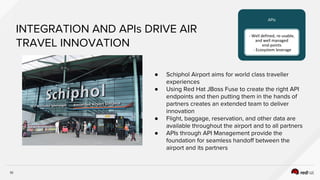






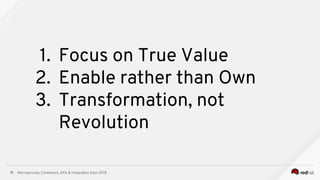









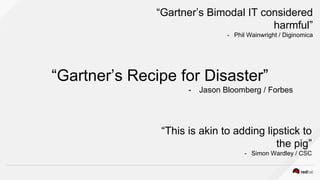




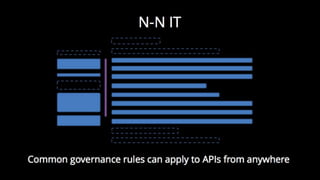












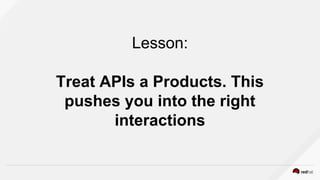





















































![[WSO2 Summit Brazil 2018] The API-driven World](https://cdn.slidesharecdn.com/ss_thumbnails/wso2-summit-brazil-2018-pzf-keynotepaul-181211071005-thumbnail.jpg?width=560&fit=bounds)





![[WSO2Con EU 2018] APIs - Technology That Can Transform Your Business Into a P...](https://cdn.slidesharecdn.com/ss_thumbnails/apistechnologythatcantransformyourbusinessintoaplatform-181114044616-thumbnail.jpg?width=560&fit=bounds)




































